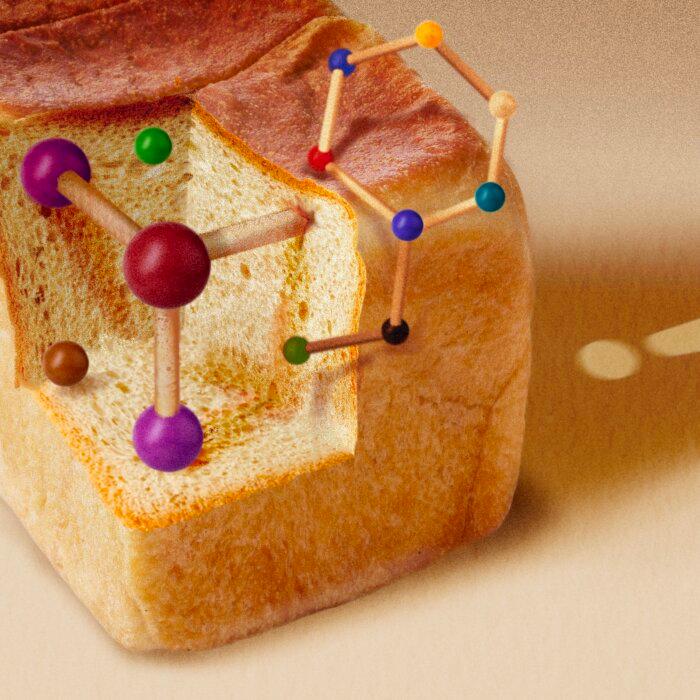Before the advent of processed foods, what we ate was grown in nature, harvested, and eaten solely for the purpose of satisfying hunger. Today, however, much of the food we eat contains
artificial ingredients and added sugars that not only provide a sense of fullness, but also induce cravings.
In 2007, researchers at the University of Bordeaux in France conducted an
experiment in which rats were offered the choice of two rewards—cocaine or saccharin-sweetened water. Even though cocaine is highly addictive, 94 percent of the mice chose the saccharin, indicating the addictive potential of intense sweetness. Their choices held even when the cocaine dosage was increased.
Rats were offered two types of rewards—cocaine and saccharin-sweetened water—each delivered by the rats pressing a lever. Starting from day 2, rats chose sweetened water over cocaine. Eventually, 94% of the rats chose saccharin. Illustration by The Epoch Times, Shutterstock
“Our findings clearly demonstrate that intense sweetness can surpass cocaine reward, even in drug-sensitized and addicted individuals,” the researchers wrote.
A 2013
review analyzed research comparing addictive drugs such as cocaine and foods high in added sugars such as sucrose to assess the validity of this theory. The researchers concluded, “At the neurobiological level, the neural substrates of sugar and sweet reward appear to be more robust than those of cocaine.”
The robust way our brains respond to sugar and sweetened foods might be why many people find it hard to stop eating them.
2 Peaks of Dopamine
Food provides us with more than an energy supply.Eating increases the level of dopamine in the brain, which makes us feel happy. The dopamine system is a critical mediator that controls our eating behavior.
In a
study conducted by researchers at Yale University and the Max Planck Institute for Metabolism Research in Germany, 13 healthy participants of normal weight received a dietary intervention of a high-fat, high-sugar milkshake or a tasteless solution in a controlled and cross-over design.
The results showed that food causes the brain to release dopamine twice.
Compared to the tasteless version, consuming a milkshake caused a significantly higher number of brain areas to exhibit a dopamine response. The first such response occurred immediately after drinking, and the second occurred around five to 10 minutes after finishing the milkshake.
As soon as food enters the mouth, the taste is quickly transmitted via the oral nerves to specific brain areas responsible for taste, eliciting a further dopamine response in the brain.
Thirteen adults were fed a milkshake or tasteless solution. In all cases and especially after drinking the flavored milkshakes, their brains released dopamine twice—once immediately after drinking, and again around 5 to 10 minutes after finishing the drink. Illustration by The Epoch Times, Shutterstock
Furthermore, MRI brain scans showed that compared to the tasteless control, the milkshake increased dopamine release across multiple regions of the brain by between 50 percent and 120 percent, showing that high fat intake and high sugar intake activate the dopamine-associated areas.
The researchers concluded that fatty, sugary foods not only easily boost the brain’s dopamine system, but also change how the brain works.
Eating Releases Opioids
Food intake also causes the release of opioids in the brain. These feel-good chemicals play a significant role in human addictions,
mediating palatability-driven eating.
In a
study published in the Journal of Neuroscience, researchers, using a contrast agent that highlights opioid receptors in the brain, scanned 10 healthy men three times: after eating a palatable meal, after eating an unpalatable meal, and after fasting overnight.
The results showed that eating led to a significant release of these opioids.
It has also been found that the activation of opioid response within 100 minutes of eating a meal may be related to the risk of regaining weight in obese individuals, according to a
study published in The Journal of Clinical Endocrinology and Metabolism.
To sum up the research, the brain reward center receives signals from natural opioids and dopamine and then sends messages to the hypothalamus to help control appetite. Diets consisting of highly processed foods with added sugars and fats take
longer to make us feel full, increasing the likelihood that we will eat more food than is optimal, which can result in weight gain and obesity.
A Food Addiction Epidemic
We live in a stressful world where work, finances, family, and health challenges stress our minds and bodies.
Suboptimal physical and emotional states drive people to seek pleasure and relief. Eating that is rewarded with the increased release of dopamine and opioids in the brain makes us feel better in the short term, but may have long-term detrimental outcomes.
Foods high in fat and sugar aren’t inherently bad—the issues arise when people lose control and use them as a means of relieving stress, consuming them excessively. This repetitive intake may lead to addiction, harming our brains and our bodies as well.
Because addiction to highly processed foods has a demonstrated link to brain function, it has been recognized that certain anti-addictive drugs may work for obesity. Here are two examples:
Bupropion is a medication that helps increase the levels of certain brain chemicals, such as norepinephrine and dopamine, which can improve mood and reduce cravings.
Naltrexone attaches to specific opioid receptors in the brain. This blocks the effects of natural chemicals called beta-endorphins, which are related to feelings of pleasure and reward. As a result, it helps reduce the urge to overeat.
But beyond these drugs, are there any natural, holistic ways to break these types of addiction?
Relief From Cravings
Over the past few decades, many studies have shown the neurological, mental, and metabolic benefits of two meditation techniques: traditional sitting meditation and modern mindfulness training. Sitting meditation involves focusing on the present moment, while mindfulness training helps with becoming fully aware of the activities in which a person is engaged.A systematic
analysis published in Obesity Reviews summarized 18 published studies on the effects of mindfulness-based interventions (MBI) on body weight. After mindfulness practice, participants were found to have lost an average of 6.8 pounds post-treatment, representing a 3.3 percent mean loss of initial body weight. During follow-ups, the participants’ average weight loss increased to 7.5 pounds.
“Our results showed that MBIs are moderately effective for weight loss,” the researchers wrote, “and largely effective in reducing obesity-related eating behaviors.”
Meditation has been linked to
higher integration of brain networks, offering the potential to normalize the abnormal dopamine release in people with addictive behavior.
In a European
study published in Cognitive Brain Research, eight healthy male meditation teachers from Copenhagen, Denmark, who had practiced daily meditation for between seven and 26 years had their brains scanned twice, once while performing meditation and once when not.
The results showed a 65 percent increase in dopamine levels in a brain region called the ventral striatum during meditation. EEG tests showed evidence of a deep relaxation mode, manifested by an increased theta wave and reduced alpha wave.
The ventral striatum is a part of the brain that helps us to feel pleasure and motivates us to seek rewards. It’s often called a “pleasure center” because it plays a key role in guiding our behavior toward things that make us happy.
Healthy male meditation teachers' brains were scanned twice, once while meditating and once not. The results showed a 65 percent increase in dopamine levels in the ventral striatum while they were meditating. The dopamine levels in the caudate and putamen areas of the brain also increased. Illustration by The Epoch Times, Shutterstock
Increasing dopamine through meditation is a more natural approach that does not carry the adverse consequences associated with anti-obesity drugs used for treating food addiction.
In 2013, scientists led by Michael Hagerty at the University of California–Davis
demonstrated that meditation can activate our dopamine reward system in the absence of any drug or pleasurable external stimulus. That’s why meditation can help people deal with
stress and the
withdrawal symptoms of addiction.
Mindfulness has been effective in
decreasing cravings among hospitalized drug abusers,
reducing substance reuse, potentially
treating chronic lower back pain and opioid addiction, and helping with
easing cravings for alcohol.
Reduce Stress-Eating
A group of German neurologists and neuroradiologists
studied 66 people who tended toward overeating when stressed. Some received mindfulness meditation training, while others received normal health training including exposure to informative, health-related video and audio clip excerpts from popular science broadcasting networks.
After mindfulness training, subjects reported lower food cravings and significantly reduced stress and emotional eating behavior. The subjects in the health training group, however, did not report the same changes.
Brain scans of the participants also indicated changes in neural connections related to areas regulating rewards, emotions, and self-awareness.
Meditation also helps with negative emotions. Another
study, published in CNS Neuroscience & Therapeutics, researched the effect of an eight-week mindfulness meditation on healthy and depressed people. All 15 participants with depression symptoms experienced a significant reduction in their depression and anxiety scores, reaching a level close to normal.
Moreover, participants experienced improved metabolism, and decreased uric acid, total cholesterol, and blood glucose, all signs of improved health.
Finding a New Balance: A Personal Note
Since moving to New York in 2022, I have been immersed in a noisy, busy, and stressful environment. My life has become fast-paced and my agenda has become busy and full.With a broad range of cuisines now available, I’ve found it hard to resist the temptation to use food for stress relief.
Luckily, with the help of friends, I gradually developed a new habit of meditating in the morning before work. I regained a better balance of those little dopamine molecules in my brain and the noisy stress hormones in my body.
On days when I do meditate in the morning, I have better control over my desire for food, and I manage my eating in a way closer to
my previous style, from when I lived in a small Swiss town with far fewer sources of external stress.
Although I miss my quiet Swiss life, this new regular meditation habit is restructuring my brain network, empowering me to better handle the difficulties and ordeals of life.
Most of my friends with strong meditation habits seem to be slim and energetic. Sitting quietly does not mean that our bodies are static, by the way. Genes, proteins, and other cell molecules can use the period of inactivity to repair our bodies at the microscopic level.
As long as we follow traditional wisdom and let our bodies naturally heal, the challenges of our modern society may be easier to overcome. With our lives and values returning to what they once were, perhaps one day all our food will be real food again.
Views expressed in this article are the opinions of the author and do not necessarily reflect the views of The Epoch Times. Epoch Health welcomes professional discussion and friendly debate. To submit an opinion piece, please follow these guidelines and submit through our form here. 
















